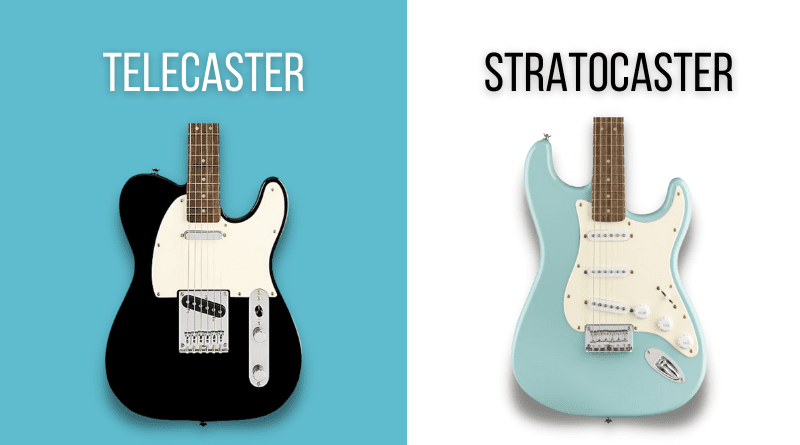Fender is without a doubt, one of the biggest names in music. Even non-guitarists are likely to be able to tell you what Fender makes when asked.
There have been dozens of unique models, and hundreds, maybe even thousands of variations of those models released in the years since the brand was launched in 1946, but no two stand out more than two of their very first guitars.
Those two models, the Telecaster and the Stratocaster are the main focus of this KillerGuitarRigs Guide, in which we’ll be taking a good look at both of these guitars, and discussing the differences between them.
Contents
- History of the Telecaster
- History of the Stratocaster
- What are the Differences Between the Fender Telecaster and the Fender Stratocaster?
- Body Differences
- Neck Differences
- Pickup Differences
- Electronics Differences
- Bridge Differences
- The Stratocaster and Telecaster Range
- FAQ
- Final Thoughts on Telecasters vs. Stratocasters
History of the Telecaster
The Fender Telecaster holds the distinguished title of “world’s first mass produced solid body electric guitar”. It was designed through the late 40s and early 50s, and was based upon the Fender Esquire, although a second pickup was added.
Interestingly, the Telecaster was originally named the Fender Broadcaster, but drum manufacturer, Gretsch, had a line of drum kits called the “Broadkaster”. Despite the difference in spelling, Gretsch complained of a trademark infringement, and so Leo Fender removed the Broadcaster decals from guitars manufactured after the fact.
This was the start of the “Nocaster” period, in which they did not feature a model name. This lasted for several months in 1951 until the Telecaster name was unveiled, and has remained ever since through the many different iterations of Telecaster that have been on the market.
History of the Stratocaster
Leo Fender was himself an engineer, not a guitarist. He saw problems, and set out to fix them – and that was his intent with the Stratocaster. He wasn’t setting out to change the world, his only mission was to build better guitars.
With lessons learned from his previous models, he began developing prototypes, and those prototypes proved to be incredibly popular with the guitarists who tried them on Fender’s behalf.
The prototypes actually looked much closer to the Telecaster than they did to what we now know as the Stratocaster. It was Fender designer, Freddy Tavares who dreamt up the now iconic shape. It was based upon the 2 horned design of the Fender Precision Bass, which was already in production at the time, and blended those features with some of those from the Telecaster.
The Strat went into production shortly after, and went on sale to the public in 1954.
What are the Differences Between the Fender Telecaster and the Fender Stratocaster?
Considering how close the two guitars are in age, the designs couldn’t be further apart. The Tele is generally considered the more conservative design of the two (something often replicated), while the Strat is a more modern shape.
Besides the immediately apparent body shape differences, there are a significant number of distinctive and unique features that these guitars possess.
Body Differences
The most noticeable difference between the two guitars when it comes to their bodies is the overall shape.
Telecaster
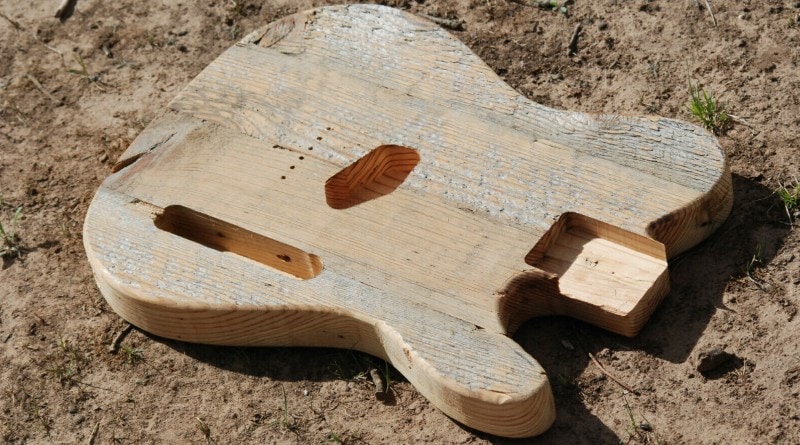
The Telecaster is designed with a thicker waist, and a single cutaway on the treble side for easier access to higher frets.
Telecasters are considered “slab” style bodies, insomuch as they are made, or appear to be made, from a single slab of wood, with no contours, or ergonomics of any kind.
The majority of Telecasters have a string through body, in which the strings are fed through ferrules on the back of the guitar and fed through the front and over the saddles. Some Telecaster models eschew the string through design in favor of top load designs, in which the strings are fed through the saddles themselves.
Traditionally, Telecaster bodies are made with ash or alder, but other materials like basswood, and even pine have been used over the years.
Stratocaster
The Stratocaster has a slimmer waist than the Tele, and of course, is designed with horns on both the bass and treble sides, a design known as double cutaway. This design offers improved access to higher frets over single cut styles.
Because of their tremolo system, most Stratocasters feature a large cavity in the middle of the backin order to accommodate the block and springs. Hardtail models, that is, those without tremolo systems are either top loaded, or string through depending on the specific model and series.
Additionally, many Stratocasters also feature additional routing behind the pickguard to accommodate multiple pickup types.
Stratocasters are usually made with the same woods as Teles, including basswood, alder and swamp ash, but special editions made with more exotic woods like rosewood, koa, maple, and others have been produced over the years.
Another notable feature of the Stratocaster is its contour body. It’s made with cutaways on the upper and lower bouts which provide improved ergonomics over the slab style body of the Telecaster.
Neck Differences
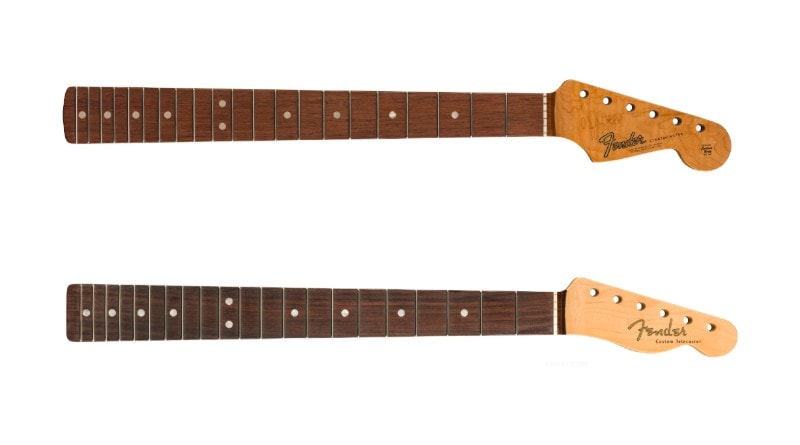
There are, in fact, very few differences between Stratocaster necks and Telecaster necks. Fender shares their profiles amongst their models, and because almost every Fender has a bolt on neck, some are even interchangeable.
Depending on the specific model you choose, you’ll find that Strats or Teles come with either a Soft V, U Shape, or the most common, the Modern C.
When it comes to radius, just like the profile, there are a number of sizes available, with none being exclusive to either model.
The vast majority of Stratocasters and Telecasters are made with maple necks. Both have the option of maple fretboards, as well as rosewood, laurel, or other rosewood substitutes. As with the body woods, there are some special edition models made with stunning 1 piece rosewood necks.
Depending on whether you’re looking at a vintage or modern model, both guitars come with either 21 or 22 frets. On vintage or reissue models you’ll find 21 narrow tall frets, and on modern models, you’ll get 22 medium jumbo frets.
So, what are the unique neck features of the Strat and the Tele?
The most obvious is the headstock. Telecasters have a slim headstock, while the headstock on Stratocasters is much larger, even larger still on models made from 1965 to 1981, and subsequent versions with 70s vintage headstocks. The additional mass of the larger headstock is thought by some to increase sustain, but any difference that exists is imperceptible to most ears.
A less noticeable, but equally important difference is the shape of the neck heel. Telecasters are made with a flat heel, while Stratocasters feature a rounded heel. As we mentioned above, some necks are interchangeable, but because of the difference in shape, there’s a good chance that the bolts won’t align properly, requiring modification to the neck pocket if you ever wanted to make this kind of exchange.
Pickup Differences
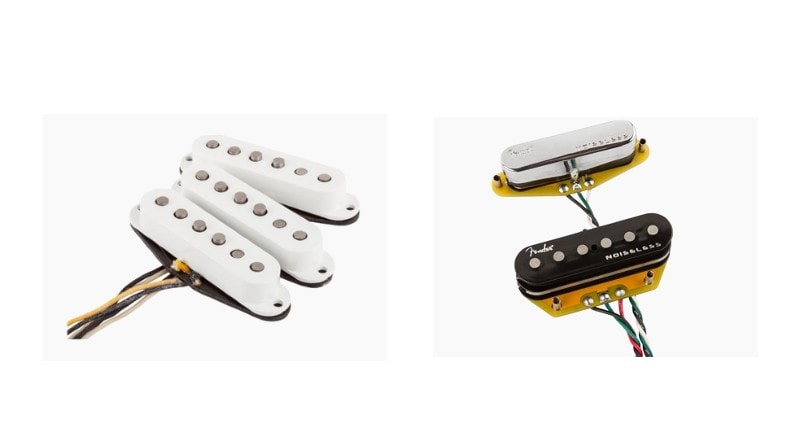
Because both the Stratocaster and the Telecaster come in a number of pickup configurations, we’ll focus primarily on the classic setups.
Telecaster Pickups
Telecasters are well known for their twangy tones, but they are also prized for their warmth and shimmer, too. All of these attributes are down to the selection and positioning of the pickups.
The single coil bridge pickup is the big attraction on a Tele, and it came about in an unexpected way. The original Telecaster bridge pickup was a modified lap steel pickup. Because it was originally intended for a lap steel, it is much longer and taller than the equivalent on the Strat. This means more wire around the bobbin, resulting in a hotter pickup.
In addition to the larger physical size, the Telecaster’s bridge pickup is mounted smack in the middle of the large metal bridge plate. This positioning results in an increased inductance of the pickup’s coils, which in turn increases its power.
In the neck position there’s another single coil pickup, although its one that is often pretty polarizing. The bridge pickups on Telecasters are so beloved that the neck pickups can sound pretty dull by comparison.
The typical Tele neck pup has a metal cover made of German steel. Many players blame the cover for the colorless tone and end up removing it, or, replacing the neck pickup altogether with something hotter with no cover.
Stratocaster Pickups
The standard Stratocaster design features 3 single coil pickups, all of which are identical in appearance. Their overall tone is renowned for being crystal clear, with sweet overtones and punchy mids.
The beauty of Strat pickups is in their simplicity, they are about as straight forward as it is possible for a pickup to be, and yet, they produce such timeless tones.
In the bridge position, the Strat produces clear tones that work brilliantly with high gain amps, making this the go to for rock players looking for big crunch.
In between the bridge and the middle, the Strat puts out its famous “quacking” tones, so named because when played clean it can sound similar to a duck’s quack. It’s a good position for clean lead guitar work.
The middle position, which is middle pickup only, is the most underused of all. Some players find that it cuts through a mix well for lead work and crunchy blues tones.
When set between the middle and the neck, you get some fantastic blues tones. The sound is similar to the bridge/middle position, but with less quack.
The neck pickup is probably the biggest draw on a Strat. It’s warm, but still retains the clarity that the model is known for. It works equally well for both rhythm and lead.
Electronics Differences
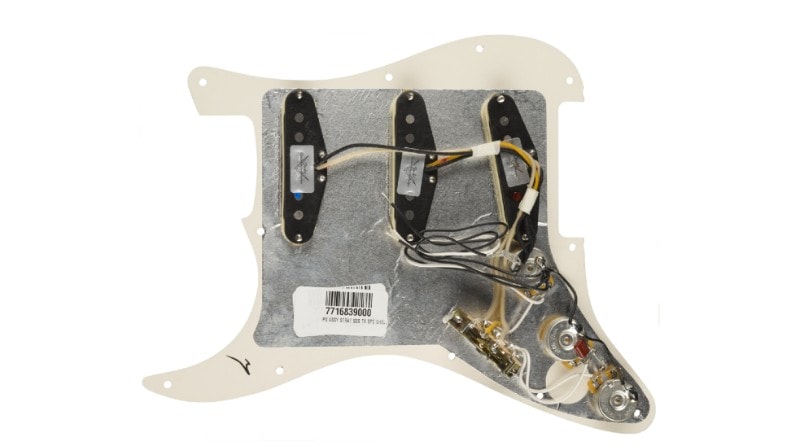
Because of the different pickups, the accompanying electronics in the Telecaster and Stratocaster also vary significantly.
Telecaster Electronics
As the Tele is set up with just 2 pickups, it only requires a 3 way selector switch, allowing players to select between the bridge, bridge/neck, and neck positions.
There are only 2 potentiometers on a Telecaster, one for volume, and one for tone. Despite the limited options for adjustments, the simple controls can actually provide quite a lot of tonal variety.
Stratocaster Electronics
Stratocasters, having 3 pickups, have additional positions available in between pickups for a total of 5 positions – bridge, bridge/middle, middle, middle/neck, and neck.
It gets a little more interesting when we look at the volume and tone controls on the Strat. There is a single master volume control, and 2 tone controls. The upper tone pot controls the neck pickup tone, while the lower controls the tone for the middle pickup.
The Strat was designed intentionally without bridge tone because this pickup Leo Fender’s vision for the tone from this setting was always a piercing, distinctive sound, similar to his lap steels. Subsequently, he didn’t believe it was necessary to be able to dampen that tone by reducing the treble.
Bridge Differences
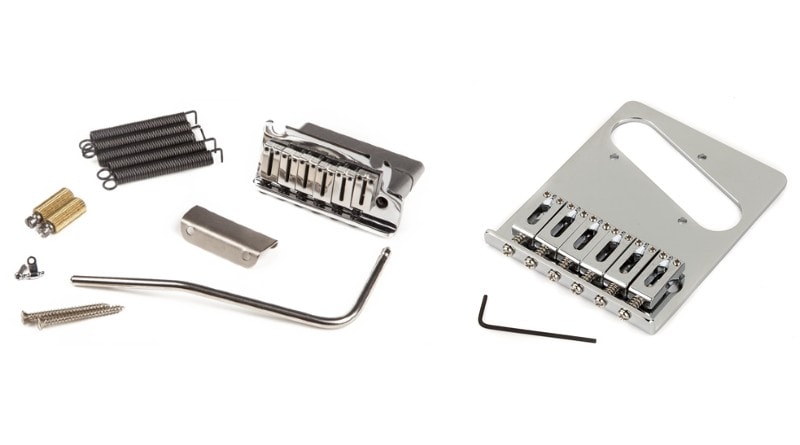
The choice of hardware is another big differentiator between the Stratocaster and the Telecaster.
Telecaster Bridge
The Telecaster’s bridge is one of its most noticeably unique features. It is a hardtail setup, (meaning no tremolo system) secured to the body by way of a large metal plate, which was designed to ensure maximum security. Some Telecasters do, however, come equipped with Bigsby trem systems.
Original Telecasters had 3 barrel style brass saddles, with 2 strings passing over each. Many purists consider this to be the only “true” Tele setup, but they are ignoring the fact that properly intonating a 3 saddle Telecaster can, in many cases be impossible. Fortunately, there are also 6 saddle versions of the Tele available, too.
Stratocaster Bridge
One of the defining features of the Stratocaster is its tremolo bridge. Stratocaster tremolo systems are suspended by either 2 or 6 screws on the front of the guitar, and counterbalanced by a heavy “trem block”, attached to a set of springs in a cavity in the back of the guitar. This system allows players to slacken, or tighten the strings momentarily for a vibrato or tremolo effect, using the tremolo arm, sometimes known as a whammy bar.
The original synchronized tremolo system is the most common bridge on Stratocasters, but a hard tail 6 saddle bridge is also a popular option. The Strat hard tail bridge is much smaller than the one on the Telecaster.
Some Strats also feature a Floyd Rose bridge, a specialist locking tremolo system that solves the tuning stability issues that can plague regular trem equipped Strats. These are most often used by players who use their tremolo frequently and heavily.
The Stratocaster and Telecaster Range
Even in their standard forms, Stratocasters and Telecasters are brilliantly versatile guitars, but when you consider the number of variants of each model, the possibilities go through the roof. Below we’ve compiled some of our favorite Strats and Telecasters
The Squier Bullet series make for an excellent introduction into guitars for a beginner, and also provide an inexpensive way for more experienced players to experiment with Strats or Teles if they aren’t familiar with them already
Squier Bullet Stratocaster
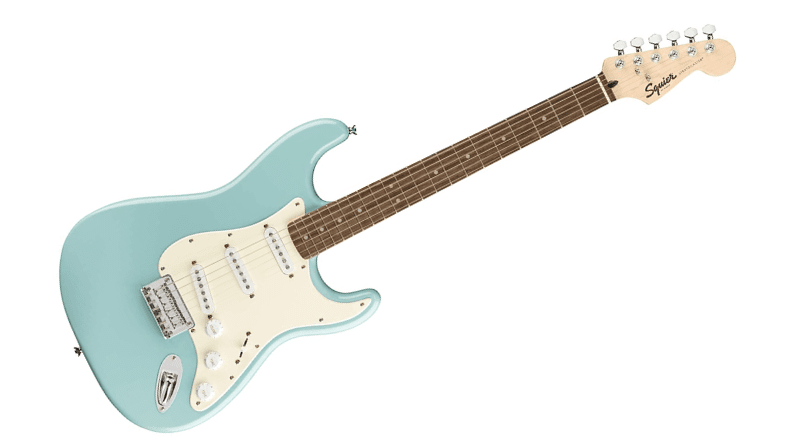
Squier Bullet Telecaster
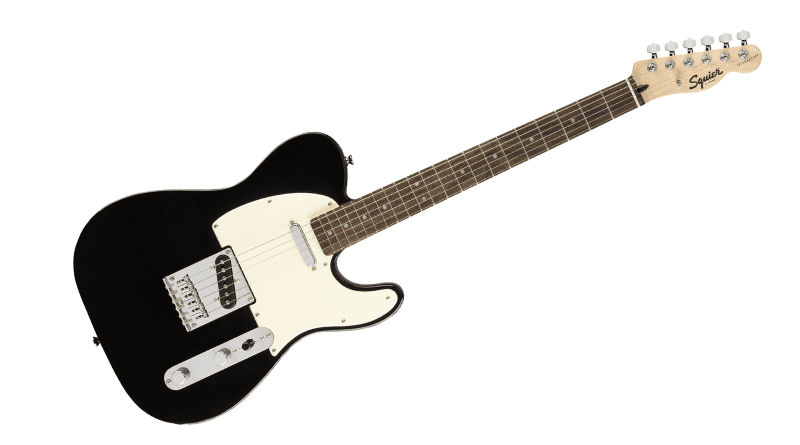
Intermediate and above players looking to keep spending to a minimum will love the Squier Classic Vibe series. These are high quality musician grade guitars that offer everything except the Fender name when it comes to sound and playability.
Squier Classic Vibe Stratocaster
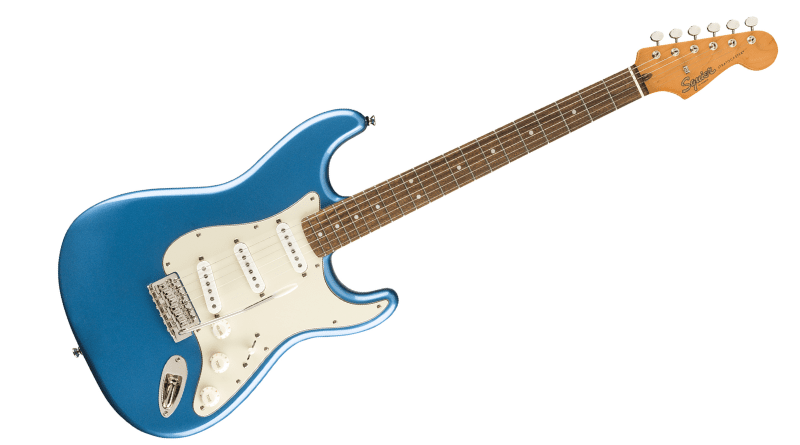
Squier Classic Vibe Telecaster
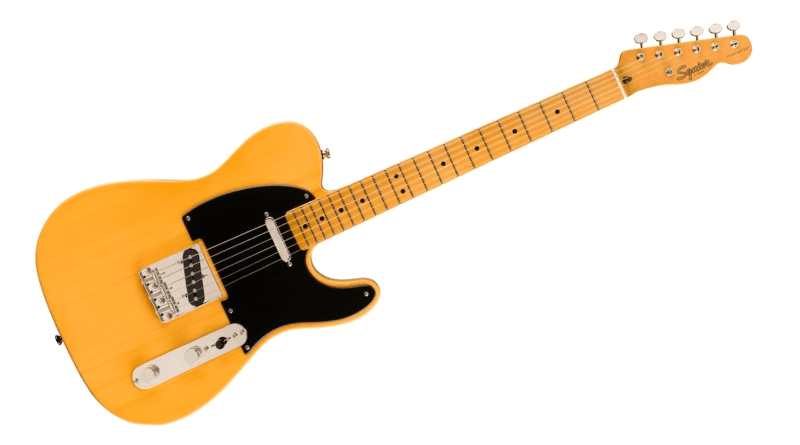
If the Fender name is a must and you’re looking for a good intermediate to advanced level guitar, the Fender Player Series Telecaster and Stratocaster are a great option. They are made in Mexico, and offer full size bodies and US Spec components, making hardware interchangeable with most American made models.
Fender Player Stratocaster
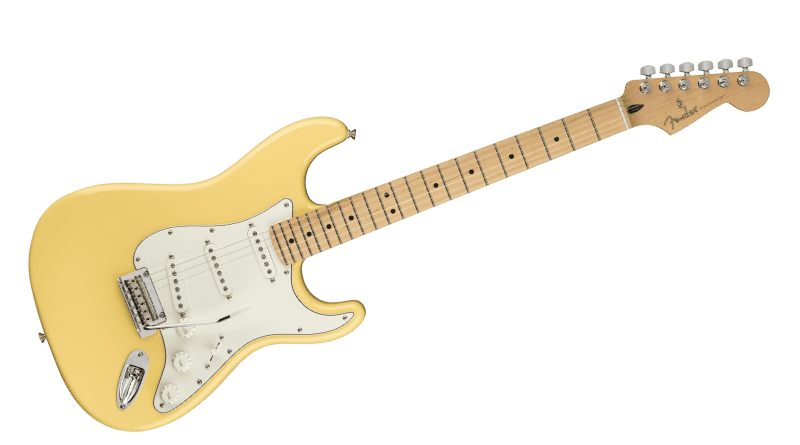
Fender Player Telecaster
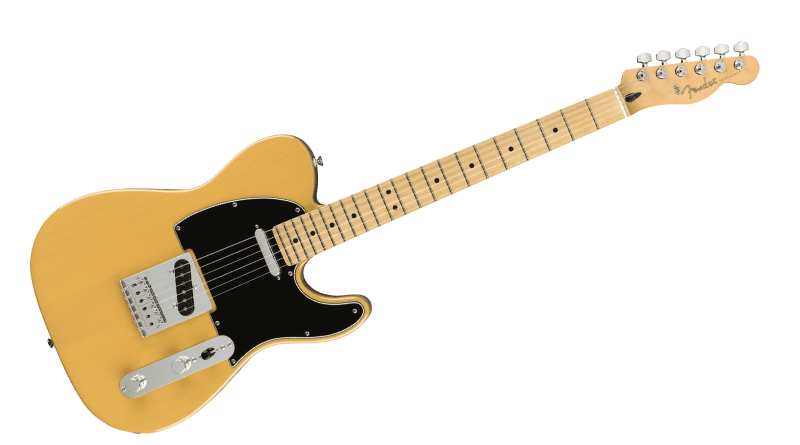
Players looking for a high end guitar should take a look at the US made line of Stratocasters and Telecasters. At the low end, these guitars sell for a little over $1200, but can cost many times over that amount if you opt for a custom shop model. The American Professional Series models are some of our favorites.
Fender American Professional Stratocaster
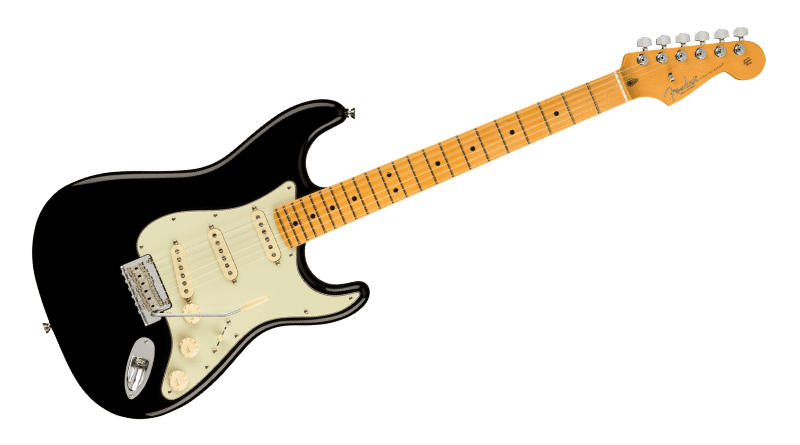
Fender American Professional Telecaster

FAQ
Which is Easier to Play – the Telecaster or the Stratocaster?
As the neck is usually the biggest indicator as to a guitar’s playability, and both the Telecaster and the Stratocaster have similar necks, it’s hard to pick out one as easier to play. What we can say, is due to the Stratocaster’s improved ergonomics over the Telecaster, many find it more comfortable, which could be measured as making it easier to play.
Which is More Expensive?
Besides custom shop and signature guitars, there are parallel models for most Telecasters and Strats, and they usually cost around the same.
Fun fact – a Stratocaster holds the record as the second most expensive guitar ever sold, with Dave Gilmour’s iconic black Strat fetching $3.9 million at auction.
Which is Better the Telecaster or the Stratocaster?
Giving an objective opinion on which of these two legendary guitars is borderline impossible. Yes, both have 6 strings and electromagnetic pickups, and both are capable of spanning the genres, but their tones are so unique, that choosing one as the best comes down to the individual.
Final Thoughts on Telecasters vs. Stratocasters
There are very few inventions that have withstood the test of time the way that solid body electric guitars have, the Telecaster and the Stratocaster being two prime examples of that statement. Not only are today’s models close to identical to the originals, but people now pay a premium to make their new guitars look like vintage 1950s models.
These guitars both offer an entirely different playing experience, different tones, and most obviously different styling. Finding out which one you prefer is definitely easiest if you take the time to physically try both models. Will the comfort and versatility of the Strat sway you in that direction, or will the classic styling and unmistakable twang pull you towards the Tele?

